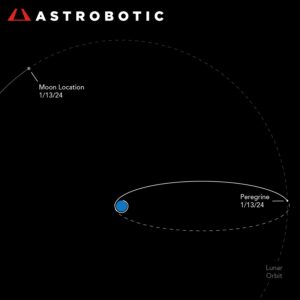Astrobotic’s Peregrine Soon to Meet Its End
The first U.S. lunar lander since the Apollo era is about to meet its end. Astrobotic’s Peregrine suffered a mission-ending propulsion failure soon after launch earlier this month. Its trajectory brought it back towards Earth and Astrobotic was able to steer it enough to direct it to reenter Earth’s atmosphere and burn up this afternoon. Peregrine is just the latest of several small, comparatively inexpensive lunar probes to fail, but that has not deterred others from trying. Japan’s next attempt is tomorrow and several U.S. private sector probes are queueing up.
Astrobotic is winning praise for its transparency about Peregrine’s problems, which developed soon after launch on January 8, 2024.
In its 20th update yesterday, the Pittsburgh-based company said the spacecraft will reenter over the Pacific Ocean at about 4:00 pm ET today. The elliptical path it was taking to the Moon brought it back towards Earth and Astrobotic coaxed the malfunctioning propulsion system to operate sufficiently to put it onto a path for destructive reentry so it does not pose a hazard to other spacecraft. All the updates are posted on Astrobotic’s website.



Peregrine is the first of several lunar landers being developed by U.S. private sector companies through Public-Private Partnerships with NASA called Commercial Lunar Payload Services (CLPS). NASA purchases services from the companies to deliver NASA science and technology payloads to the lunar surface. The companies are expected to find other customers to close the business case.
Peregrine is carrying 20 payloads from 17 customers including five from NASA. Astrobotic was able to activate the nine experiments designed to obtain power from and communicate with the lander. Two of NASA’s payloads, the Neutron Spectrometer System (NSS) and Linear Energy Transfer Spectrometer (LETS), were able to collect and transmit data about the radiation environment in cislunar space.

One of the payloads for a non-NASA customer, Celestis, created some controversy because it contains cremated human remains, or cremains. The Navajo Nation objects to sending human remains to the Moon, which they consider sacred. NASA arranged to send the remains of a famed scientist to the Moon over 20 years ago and later promised the Navajo that it would consult with them before doing it again. Navajo Nation President Buu Nygren wrote to NASA and the Department of Transportation, which regulates commercial launches, complaining they were not consulted and also pointing out the Biden Administration agreed to consult with matters that impact tribes.
The Biden Administration agreed to meet with Nygren. He was interviewed by Native News Online on January 8 after Peregrine was launched (the interview aired on January 12) and said he had met with NASA Administrator Bill Nelson and officials from the White House and DOT on January 5 where Nelson reiterated NASA’s commitment to consult with the Navajo with regard to NASA missions. This is not a NASA mission, however, it is a private sector mission. Nygren’s position is that since NASA is paying $100 million or more for these missions, it has influence and should prevent human remains from being sent to the Moon even by the private sector.
In a statement to SpacePolicyOnline.com on January 18, NASA clarified that a NASA representative, not Nelson, attended the intergency meeting on January 5, but Nelson spoke with Nygren over the phone and looks forward to meeting him in person to continue the discussion.
“I had the honor of speaking with Buu Nygren, president of The Navajo Nation, on the phone earlier this month to hear concerns about the commercial payloads aboard the Astrobotic Peregrine Mission One flight. I look forward to continuing this dialog by meeting with him in person in the future.” — Bill Nelson
DOT’s FAA Office of Commercial Space Transportation, which regulates commercial launches, did not respond to SpacePolicyOnline.com’s requests for comment.
Peregrine was to be the first U.S. lunar lander since Apollo 17 in 1972. The six Apollo missions that landed on the Moon between 1969 and 1972 are the only lunar landers that carried astronauts. All of the others launched by the United States and Soviet Union in the 1960s and 1970s, and by the governments of China, India, and Japan and private entities like Astrobotic since 2013 are robotic. NASA expects to return astronauts to the Moon in 2026 through the Artemis program.
In the past decade, only government-built spacecraft have landed successfully: China’s Chang’e-3/Yutu lander/rover in 2013, Chang’e-4/Yutu-2 far-side lander/rover in 2019 and Chang’e-5 sample return mission in 2020; and India’s Chandrayaan-3 in 2023.
Attempts by others, both governments and private entities, have failed: an Israeli non-profit, SpaceIL, with its Beresheet lander in 2019; India’s first attempt with Chandrayaan-2 in 2019; the Japan Aerospace Exploration Agency (JAXA’s) first attempt with the OMOTENASHI cubesat launched on the Artemis I test flight in 2022; a Japanese commercial company, ispace, with HAKUTO-R M1 in May 2023; and the Russian government’s Luna-25 in August 2023.
JAXA will try again tomorrow. The Smart Lander for Investigating Moon (SLIM), also known as Moon Sniper, is scheduled to land at 10:40 am ET (January 20, 12:20 am Japan Standard Time). JAXA will webcast the landing. If successful, Japan will be the fifth country to make a survivable landing on the Moon.
Later that day, Astrobotic and NASA will hold a media teleconference to discuss what happened with Peregrine. NASA’s Joel Kearns, who oversees the CLPS program, is one of the participants. The next CLPS mission is scheduled for launch next month, Intuitive Machines’ Nova-C, and at least four more CLPS missions are scheduled this year.
This article has been updated.
User Comments
SpacePolicyOnline.com has the right (but not the obligation) to monitor the comments and to remove any materials it deems inappropriate. We do not post comments that include links to other websites since we have no control over that content nor can we verify the security of such links.